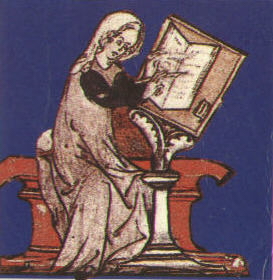|

Lesson Four:
The Norman Invasion & The Arthurian Legends
|
| Required Materials
|
|
Videos & Recordings:
Study each of these and take notes!
|

Lesson Four
(Part 3: Cultural Transitions)
This video is temporarily out of order.
It is currently being revised and reloaded.
It will be available by Feburary 1, 2015 (Sunday).. |
 Lesson Four Lesson Four(Part 4: The Arthurian Legends)
This video is temporarily out of order.
It is currently being revised and reloaded.
It will be available by Feburary 1, 2015 (Sunday).. |
|
|
|
The Norman Invasion and a Few Other Key Points of History

The Big Picture of the British Islands
(ABSURDLY OVER-SIMPLIFIED) |
YEARS |
SOCIETIES |
RULING |
BELIEFS |
GENDER EQUITY |
LANGUAGES |
POETICS |
Pre-English Language (Literary & Oral) History |
? B.C.E.
to
c.a. 43 C.E. |
The Celtic People were warrior/tribal society |
the family creates the state |
Pagan |
patriarchal
(more equalitarian) |
Various Gaelic (Celtic) Languages |
oral; not much known |
|
The Roman invasion disrupted that slightly |
the state is over the family |
Christian |
patriarchal |
Celtic Languages,
Latin |
literary; influenced by Celtic oral poetics |
Legends of King Arthur begin |
The Beginning of English Language History |
|
The Anglo-Saxon invasion re-enhanced it |
the family creates the state |
Pagan/Christian |
patriarchal |
Old English,
Latin |
oral/literary; Anglo-Saxon versification |
|
The Viking invasions continued it |
the family creates the state |
Pagan/Christian |
patriarchal
(slightly equalitarian) |
Old English,
Latin |
oral/literary; Anglo-Saxon versification |
|
The Norman invasion introduced a feudal society |
the church is over the state as well as over the family |
Christian |
patriarchal |
French,
Latin,
English
Celtic Languages |
literary; French-influenced versification |
Legends of King Arthur Rekindle; Legends of Robin Hood Begin |
The Anglo-Saxon Heroic Code vs. The Code of Chivalry
Anglo-Saxon Heroic Code |
Code of Chivalry |
~~ stoicism, strength, bravery, honor,
loyalty, honesty, selflessness, generosity, pride (confidence), fame and glory
~~ a retainer (warrior) holds
loyalty to the king (defend to the death)
~~
the king is protected by a body of retainers (most likely family)
~~
the custom of gift-giving and the king as "ring-giver"
~~
blood vengeance: a warrior must seek compensation for the death or injury of a kinsman, either through the death of another or with weargild (blood money)
~~
the importance of living forever in story/history with fame and glory
~~
the horror of living forever in story/history in shame
~~
a boast is not at all a bad thing, if it can be supported
~~ a respect for Wyrd (goddess of fate), and later of God
|
~~ oaths of loyalty (in this order) to: God, King, Fair Lady
~~ faith
~~
hope
~~ charity
~~ justice
~~ wisdom
~~ honesty
~~ courtesy
~~ humility
~~ valor
~~ generosity
~~ protect the weak
~~ rescue damsels in distress
~~ never resist fighting all dragons, evil men, giants, and other monsters
|
The Art of Courtly Love
(This is very secular--the Church did not approve of most of these rules!) |
SOURCE: Andreas Capellanus: The Art of Courtly Love (c.a. 1170s)
1. Marriage is no real excuse for not loving.
2. He who is not jealous cannot love.
3. No one can be bound by a double love.
4. It is well known that love is always increasing or decreasing.
5. That which a lover takes against his will of his beloved has no relish.
6. Boys do not love until they arrive at the age of maturity.
7. When one lover dies, a widowhood of two years is required of the survivor.
8. No one should be deprived of love without the very best of reasons.
9. No one can love unless he is impelled by the persuasion of love.
10. Love is always a stranger in the home of avarice.
11. It is not proper to love any woman whom one should be ashamed to seek to marry.
12. A true lover does not desire to embrace in love anyone except his beloved.
13. When made public love rarely endures.
14. The easy attainment of love makes it of little value; difficulty of attainment makes it prized.
15. Every lover regularly turns pale in the presence of his beloved.
|
16. When a lover suddenly catches sight of his beloved his heart palpitates.
17. A new love puts to flight an old one.
18. Good character alone makes any man worthy of love.
19. If love diminishes, it quickly fails and rarely revives.
20. A man in love is always apprehensive.
21. Real jealousy always increases the feeling of love.
22. Jealousy, and therefore love, are increased when one suspects his beloved.
23. He whom the thought of love vexes, eats and sleeps very little.
24. Every act of a lover ends with in the thought of his beloved.
25. A true lover considers nothing good except what he thinks will please his beloved.
26. Love can deny nothing to love.
27. A lover can never have enough of the solaces of his beloved.
28. A slight presumption causes a lover to suspect his beloved.
29. A man who is vexed by too much passion usually does not love.
30. A true lover is constantly and without intermission possessed by the thought of his beloved.
31. Nothing forbids one woman being loved by two men or one man by two women.
|
The Anglo-Norman Dialect
French was a dialect of Latin
Normandy is a Germanic part of France (Norman = Norsemen)
Norman French was a Germanic French
Anglo-Norman was a dialect of Norman French and Old English
|
SAMPLE: The Ancrene Riwle (Ancrene Wisse)

|
The Ancrene Wisse
(The Ancrene Riwle)
Book VII
|
~~How is Christ portrayed in this story?
~~ How does the hero Christ in this story compare/contrast with the hero Christ in "The Dream of the Rood"?
~~ What elements of chivalry are portrayed in this story?
~~ What elements of Courtly Love are portrayed in this story?
|
~~ What is an anchoress?
~~ The anchorage as a sort of sanctuary
~~ An anchorite/anchoress vs. a hermit
~~ Who was the author?
~~ Who was the audience?
|
The Celtic Revival
~~ The courts of Henry II and Eleanor of Aquitaine were fascinated by the oral stories of the Celtic people, especially those about King Arthur.
~~ Wace was endorsed by Queen Eleanor, and it is possible that Marie de France was King Henry II's sister.
~~ King Henry II claimed to have sources for King Arthur's burial and, with much fanfare and secrecy, had people dig up his grave (which was apparently 16 feet under ground).
~~ While the Celtic people still thrived both on the British Isles and in Europe (for example: Scotland, Whales, Ireland, Cornwall, and Brittany), they had become a marginalized people (a minority).
~~ The Celtic people had become, for the dominate ruling French class, an exotic or charming people, and the stories that traveling minstrels told were considered delightful.
~~ What better way, too, to culturally oppress the English peoples than by recognizing the stories and histories of the people they had conquered so many centuries earlier (conquering the conquer ers of the conquered who still claimed that King Arthur would rise again).
A Sample of Layamon's Worcestershire
(Southwest Midland) Dialect (Brut):
|
Consider (and/or Reconsider):
 Old English Anglo-Norman vs. Old French Anglo-Norman vs. Latin Old English Anglo-Norman vs. Old French Anglo-Norman vs. Latin
 Transculturation: A process in which a subordinated group assimilates (takes in; transforms) cultural materials from the dominate group. Transculturation: A process in which a subordinated group assimilates (takes in; transforms) cultural materials from the dominate group.
~~ Who was dominating whom (culturally)?
~~ The Warrior Heroic Code vs. The Chivalric Heroic Code
~~ The importance of establishing heroic lineage vs. the importance of generating historical context
~~ The Feudal System
~~ The Medieval Understanding of the Cosmic Order
~~ Consider the Meaning of the Word Patient
~~ Geoffrey of Monmouth
~~ Fiction vs. Fact (History vs. Story)
~~ The Chivalric Romance (a.k.a. Medieval Romance): "A tale of adventure in which knights, kings, or distressed ladies motivated by love, religious faith, or the mere desire for Adventure, are the chief figures." (A Handbook to Literature; William Harmon and Hugh Holman)
~~Couplet: (see your textbook)
~~ Wace's Le Roman de Brut: language, poetics, speech rhetoric, characterization, heroics, and contributions to the Arthurian Legends
~~ Layamon's Brut: language, poetics (Old English Poetics vs. Old French poetics), allegorical dreams, foreshadowing, characterization, heroics, and contribution to the Arthurian legends
~~Marie de France's "Lanval": rules of celtic fairy lore, Old French poetics, characterization, chivalry, courtly love, contribution to Arthurian Legends
What makes the fairy queen a fair lady
(beautiful)?
How would you characterize Queen Guinevere and King Arthur in this tale?
What is the significance of Gawain--what
does he contribute to the tale?
Examine the ways in which Lanval is a good,
chivalric knight.
Examine which rules of courtly love are
followed, and which rules are not.
Thus examine the ways in which Marie de
France cleverly mixes the supposedly un-
mixable: chivalry and courtly love.
|
|
| Supplemental Materials |
The Platagenet World (e.g., Henry II & Eleanor of Aquitaine)
|
|
Wace: Prose Brut (Anglo-Norman version)

Copyright © The British Library
(Click on the image for an enlarged view.)
The initial ‘P’, skillfully executed in brown ink, begins Wace’s Roman de Rou. The poem was copied by a near-contemporary to the scribe who wrote Geoffrey of Monmouth’s Historia Britonum that precedes it in the manuscript. |
|
The circular diagram shows the Heptarchy or the seven Anglo-Saxon kingdoms, Northumbria, Mercia, East Anglia, Essex, Kent, Sussex and Wessex, that eventually became the kingdom of England. Each kingdom is represented by a circle, situated accordingly to its geographical location and provided with a short description in Latin. The diagram prefaces two verse chronicles of England, Wace’s Roman de Brut and Gaimar’s Estoire des Engles and perhaps imitates the introductory role played by the Heptarchy in the genealogical roll-chronicles of the English kings, popular during the fourteenth century. |

Portrait of Marie de France |
TEXT:
A Sample of Torture as Punishment and Treatment

|
| Links of Interest to this Lesson |
|
|
|
| Links of Interest to Medieval Studies |
| |
|
|